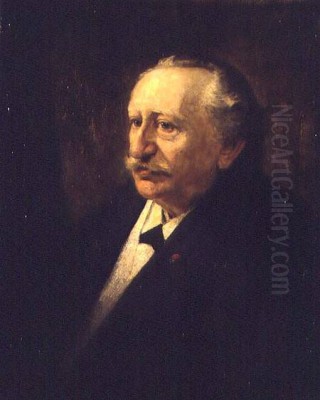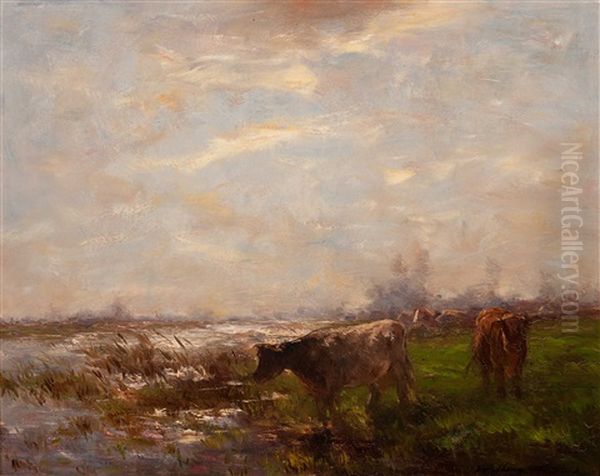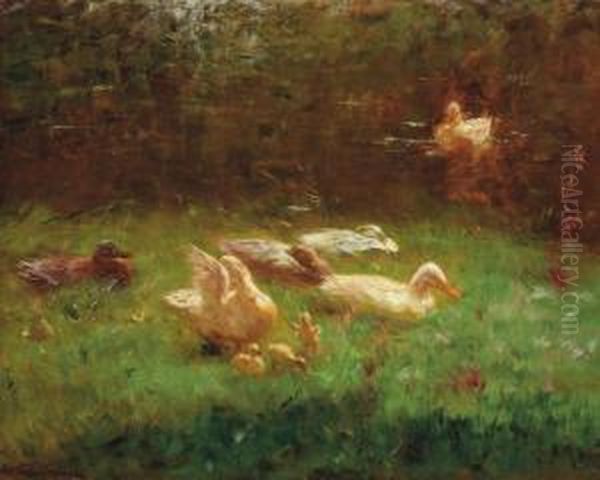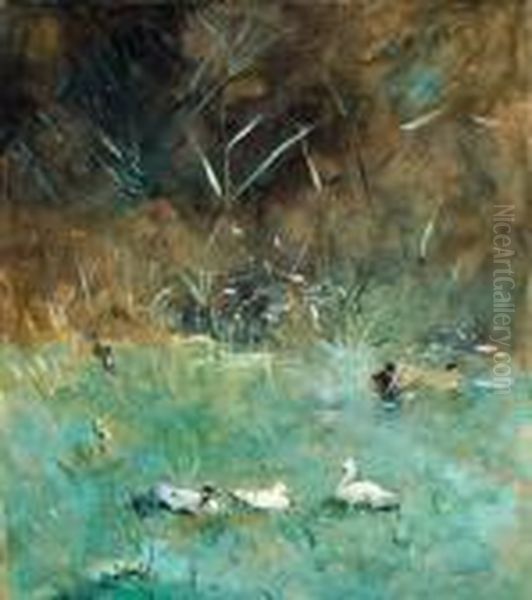
Willem Maris stands as a significant figure in nineteenth-century Dutch art, celebrated primarily for his evocative landscape paintings. Born in The Hague in 1844, he emerged as a leading member of the Hague School, a movement that revitalized Dutch painting by turning towards realistic depictions of the local environment and daily life. Unlike many contemporaries who focused on the somber aspects of peasant or fishing life, Willem Maris became renowned for his luminous portrayals of the Dutch polder landscape, particularly scenes featuring cattle and waterfowl near water, bathed in the distinctive light of the Netherlands. His lifelong fascination with capturing the effects of light earned him the reputation as the preeminent "Impressionist" among his Hague School peers.
Early Life and Artistic Formation
Willem Maris was born into an exceptionally artistic family. His two older brothers, Jacob (1837-1899) and Matthijs (1839-1917), were already establishing themselves as painters when Willem began to show artistic inclinations. This familial environment provided his initial, and perhaps most crucial, artistic education. While he received some formal instruction at the Hague Academy of Art, Willem was largely self-taught, absorbing lessons primarily through observation and practice, guided significantly by his accomplished brothers. Jacob, in particular, known for his atmospheric landscapes and townscapes, likely offered foundational guidance.
During his formative years, Willem sought inspiration directly from nature. He spent considerable time sketching outdoors, particularly in the rural areas surrounding The Hague and later near the village of Oosterbeek. Oosterbeek, often dubbed the "Dutch Barbizon," was a gathering place for artists seeking to paint directly from nature, following the example of the French Barbizon School painters like Jean-Baptiste-Camille Corot and Théodore Rousseau. It was here, around 1862, that Maris forged a close and lasting friendship with Anton Mauve (1838-1888), another pivotal figure of the Hague School, known for his sensitive depictions of sheep and rural scenes. This friendship proved mutually beneficial, providing companionship and likely artistic exchange.

Early influences also included animal painters from the Dutch Golden Age, such as Paulus Potter, whose meticulous rendering of cattle resonated with Maris's chosen subject matter. However, Willem quickly moved beyond mere imitation, developing a personal style focused more on atmosphere and light than on precise anatomical detail. His early works, while demonstrating careful observation, already hinted at the preoccupation with light that would define his mature career.
The Hague School Context
The Hague School emerged in the latter half of the 19th century as a reaction against the prevailing Romantic and Academic traditions in Dutch art. Its members sought authenticity and a return to the perceived honesty of Dutch 17th-century masters, but interpreted through a contemporary lens. They favoured realistic subjects drawn from their immediate surroundings: the flat polder landscapes, canals, windmills, fishing villages along the coast, and the interiors of rural homes. Key figures included Jozef Israëls (1824-1911), often considered the leader, known for his poignant scenes of fisherfolk; Hendrik Willem Mesdag (1831-1915), famous for his dramatic seascapes; Johannes Bosboom (1817-1891), who specialized in church interiors; and Willem's own brothers, Jacob and Matthijs.
The movement was significantly influenced by the French Barbizon School. Artists like Constant Troyon (1810-1865), admired for his paintings of cattle in landscapes, and Charles-François Daubigny (1817-1878), known for his river scenes painted from a boat, provided models for painting outdoors and capturing natural effects. The Hague School artists adopted this plein-air approach, though their palettes initially tended towards more subdued, tonal harmonies – often characterized by greys, browns, and muted greens – reflecting the often overcast Dutch climate. This earned them the nickname "The Grey School" in their early days.
Willem Maris operated firmly within this milieu. He shared the group's commitment to depicting the Dutch landscape realistically and their interest in the effects of atmosphere. However, his particular emphasis on sunlight and vibrant light effects gradually set him apart, pushing the boundaries of the Hague School's typically more tonal approach towards something closer to French Impressionism, though always retaining a distinctly Dutch character. He became a prominent member of the Pulchri Studio, the Hague artists' society, facilitating interaction and exchange with fellow members like Israëls, Mesdag, and Mauve.
Maris's Signature Style: The Primacy of Light

Willem Maris is perhaps best known for his famous statement, "Ik schilder geen koeien, maar licht" – "I don't paint cows, but light." This quote encapsulates the core of his artistic philosophy and distinguishes his work within the Hague School. While cattle, ducks, and watery meadows were his recurrent subjects, they served primarily as vehicles for his exploration of light. He was less interested in the animals as specific individuals or symbols, and more fascinated by how sunlight struck their hides, reflected off the water's surface, or filtered through the moist atmosphere of the Dutch lowlands.
His paintings masterfully capture the interplay of light and water. He excelled at depicting the shimmering reflections in ditches and ponds, the bright glare of summer sun on a wet meadow after a shower, or the softer, diffused light of an overcast day. He often positioned his subjects, particularly cows standing near water, to maximize the effects of backlighting (contre-jour), creating sparkling highlights along their contours and emphasizing the contrast between shadow and intense light. The texture of a cow's coat became a surface to catch and reflect sunlight, rendered with increasingly broad and confident brushstrokes.
Compared to the French Impressionists like Claude Monet (1840-1926) or Alfred Sisley (1839-1899), who often used broken color and optical mixing to represent fleeting light, Maris's approach remained rooted in a more tonal structure, yet his palette brightened considerably over his career. He employed bolder colours and a more vigorous application of paint than many of his Hague School colleagues, effectively conveying the vibrancy and intensity of light in the Dutch landscape. This focus made him arguably the most "Impressionistic" painter of the group.
Subject Matter: The Dutch Meadow
The quintessential Willem Maris painting features cows or ducks in a lush, waterlogged meadow under a wide Dutch sky. This focus on the polder landscape, with its ditches, pools, and grazing animals, was central to his oeuvre. He found endless inspiration in the simple, everyday scenes of the countryside near The Hague and later around Rijswijk, where he eventually settled. His depictions are not dramatic or idealized; rather, they convey a sense of tranquility and the quiet rhythm of rural life.

Cattle were a favourite motif. He painted them standing in water, grazing peacefully, or resting in the shade. His cows are sturdy, tangible presences, yet rendered with a looseness that integrates them fully into the surrounding atmosphere. The water, whether a narrow ditch or a broader pool, was equally important, serving as a mirror reflecting the sky, the animals, and the surrounding vegetation, adding complexity and luminosity to the scene. Ducks paddling or preening near the water's edge provided another recurring motif, allowing for further studies of reflection and movement.
While landscape dominated, Maris did occasionally produce other works. Some sources mention portraits, such as the Elliptical Portrait of a Lady, indicating a versatility beyond his primary focus. He was also a skilled watercolourist, using the medium often for studies but also for finished works that possess a remarkable freshness and transparency, perfectly suited to capturing the fleeting effects of light and moisture. A work like the watercolour study A Cow Lying Down demonstrates his facility in this medium and likely informed his oil paintings of similar subjects.
Evolution and Impressionism
Willem Maris's artistic style was not static; it evolved significantly throughout his career. His earlier works, from the 1860s and early 1870s, show a greater attention to detail and a more tightly controlled technique, clearly aligned with the realistic tendencies of the early Hague School. Paintings like Calves at a Trough (1873), while demonstrating his interest in light, retain a more solid rendering of form compared to his later output. This particular work, when exhibited, received somewhat mixed reviews, with critic Theophile de Bocock finding it less compelling than a work by his brother Matthijs shown at the same time, indicating that Willem's unique vision was still developing and perhaps not yet fully appreciated.
From the mid-1870s onwards, influenced perhaps by the growing awareness of French Impressionism and driven by his own deepening exploration of light, Maris's style became progressively looser, brighter, and more atmospheric. His brushwork grew bolder and more visible, defining form through patches of colour and light rather than precise lines. His palette shifted away from the predominantly grey and brown tones of the early Hague School towards brighter greens, blues, and yellows, capturing the brilliance of sunlight more directly.
This later phase, particularly from the 1880s until his death, represents the height of his "Impressionist" style. Works like Meadow with Cows by the Water (painted between 1895-1904) exemplify this mature approach: the forms of the cows are suggested rather than meticulously detailed, the water sparkles with reflected light rendered through dynamic brushstrokes, and the entire scene is unified by a palpable sense of light and air. It was this vibrant, light-filled style that cemented his reputation as a leading figure in Dutch art and garnered significant international acclaim.
Representative Works
Several paintings stand out as representative of Willem Maris's artistic achievement and stylistic development:
Calves at a Trough (1873): An earlier work showcasing his interest in cattle and rural scenes. While demonstrating his skill in capturing light, particularly on the animals' hides, the rendering is relatively detailed compared to his later style. Its initial reception highlights the evolving tastes of the time.
Meadow with Cows by the Water (c. 1895-1904): A quintessential example of his mature style. This work embodies his focus on light, with brilliant reflections on the water and sunlight catching the backs of the cows. The brushwork is loose and confident, conveying the atmosphere of a bright, moist Dutch meadow. Variations on this theme became his hallmark.
Ducks (various dates): Maris frequently painted ducks near the water's edge, often using them as focal points to explore reflections and the interplay of light on water and feathers. These works are typically smaller in scale but demonstrate the same mastery of light and atmosphere.
Landscape met cows (various dates): This general title covers many works that define his contribution. They typically feature one or more cows in a characteristic Dutch polder landscape, emphasizing the horizontal expanse, the watery ditches, and the overarching sky, all unified by his treatment of light.
A Cow Lying Down (oil and watercolour versions): The existence of both a watercolour study and an oil painting of this subject illustrates his working process. The watercolour likely served as a preparatory sketch, capturing the pose and light effects quickly, which were then developed further in the more substantial oil medium.
These works, and many others like them, are held in major collections, including the Rijksmuseum in Amsterdam, the Kunstmuseum Den Haag, and the Dordrechts Museum, testifying to their enduring importance in Dutch art history.
Relationships and Interactions
Willem Maris's artistic life was deeply intertwined with his family and fellow artists. The influence of his brothers, Jacob and Matthijs, was foundational, providing both initial training and a stimulating, if sometimes competitive, artistic environment. While Jacob became famous for his broad, atmospheric landscapes and cityscapes, and Matthijs pursued a more mystical, Symbolist direction, Willem carved out his own niche with his light-filled meadow scenes. Despite their differing paths, the Maris brothers remained a central force within the Hague School.
His friendship with Anton Mauve was significant. Their meeting in Oosterbeek marked the beginning of a long association between two artists who shared a love for the Dutch landscape and a sensitivity to atmospheric effects, although Mauve is perhaps best known for his depictions of sheep. They were both key members of the Hague School and the Pulchri Studio, fostering a sense of community among the Hague artists.
Through the Pulchri Studio and other interactions, Maris was connected to the leading figures of the movement, including Jozef Israëls, the patriarch of the school; Hendrik Willem Mesdag, the maritime painter; and landscape specialists like Paul Gabriël (1828-1903), known for his clear, bright polder scenes which sometimes rivaled Maris's own luminosity. He would also have known figures like Johannes Bosboom and the younger generation associated with the school. This network provided opportunities for exhibition, discussion, and mutual support. While Maris developed a highly individual style, it was nurtured within this collaborative and dynamic artistic community.
Reception and Legacy
Willem Maris achieved considerable success during his lifetime, particularly in his later years. His luminous landscapes found favour with Dutch collectors and also gained significant recognition internationally, especially in Britain and North America, where Hague School paintings were actively collected. Art dealers, possibly including firms like Goupil & Cie (where Theo van Gogh, brother of Vincent van Gogh, worked for a time), played a role in promoting his work abroad. Vincent van Gogh himself admired the Hague School painters, particularly Mauve, and drew inspiration from their realistic approach to landscape and peasant life early in his own career.
While some contemporary critics occasionally found fault, perhaps perceiving a lack of detailed finish in his increasingly loose, Impressionistic works (a common criticism leveled against Impressionists everywhere), his reputation grew steadily. Posthumously, his status as a major figure was confirmed. Reviews and articles published after his death in 1910, such as those noted in Dutch and British newspapers around 1915, solidified his place as one of the most important Dutch landscape painters of his generation.
His legacy lies in his unique contribution to the Hague School and Dutch Impressionism. He pushed the boundaries of the school's initial tonalism, infusing his canvases with an unprecedented vibrancy and focus on light. While the subsequent generation of Amsterdam Impressionists, including George Hendrik Breitner (1857-1923) and Isaac Israëls (1865-1934, son of Jozef), moved towards urban subjects and an even bolder style, Maris's work served as a crucial bridge. He demonstrated how the principles of Impressionism could be adapted to the specific conditions and traditions of Dutch landscape painting.
Conclusion
Willem Maris remains a beloved and important figure in Dutch art history. As a key member of the influential Maris family and the Hague School, he played a vital role in the revitalization of Dutch painting in the 19th century. His unwavering dedication to capturing the effects of light, particularly within the context of the Dutch meadow landscape with its characteristic cattle and water, resulted in a body of work that is both deeply rooted in Dutch tradition and remarkably forward-looking in its embrace of Impressionistic techniques. His famous assertion that he painted "light" above all else perfectly captures the essence of his artistic quest. Through his luminous canvases, Willem Maris not only offered a unique vision of the Netherlands but also secured his position as one of the country's most significant interpreters of light and landscape.